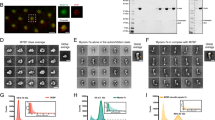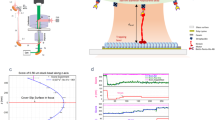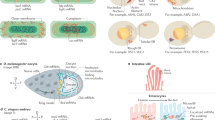Abstract
Molecular motors are instrumental in mRNA localization, which provides spatial and temporal control of protein expression and function. To obtain mechanistic insight into how a class V myosin transports mRNA, we performed single-molecule in vitro assays on messenger ribonucleoprotein (mRNP) complexes reconstituted from purified proteins and a localizing mRNA found in budding yeast. mRNA is required to form a stable, processive transport complex on actin—an elegant mechanism to ensure that only cargo-bound motors are motile. Increasing the number of localizing elements ('zip codes') on the mRNA, or configuring the track to resemble actin cables, enhanced run length and event frequency. In multi–zip-code mRNPs, motor separation distance varied during a run, thus showing the dynamic nature of the transport complex. Building the complexity of single-molecule in vitro assays is necessary to understand how these complexes function within cells.
This is a preview of subscription content, access via your institution
Access options
Subscribe to this journal
Receive 12 print issues and online access
$189.00 per year
only $15.75 per issue
Buy this article
- Purchase on Springer Link
- Instant access to full article PDF
Prices may be subject to local taxes which are calculated during checkout





Similar content being viewed by others
References
Sil, A. & Herskowitz, I. Identification of asymmetrically localized determinant, Ash1p, required for lineage-specific transcription of the yeast HO gene. Cell 84, 711–722 (1996).
Bobola, N., Jansen, R.P., Shin, T.H. & Nasmyth, K. Asymmetric accumulation of Ash1p in postanaphase nuclei depends on a myosin and restricts yeast mating-type switching to mother cells. Cell 84, 699–709 (1996).
Long, R.M. et al. Mating type switching in yeast controlled by asymmetric localization of ASH1 mRNA. Science 277, 383–387 (1997).
Takizawa, P.A., Sil, A., Swedlow, J.R., Herskowitz, I. & Vale, R.D. Actin-dependent localization of an RNA encoding a cell-fate determinant in yeast. Nature 389, 90–93 (1997).
Hodges, A.R., Krementsova, E.B. & Trybus, K.M. She3p binds to the rod of yeast myosin V and prevents it from dimerizing, forming a single-headed motor complex. J. Biol. Chem. 283, 6906–6914 (2008).
Krementsova, E.B. et al. Two single-headed myosin V motors bound to a tetrameric adapter protein form a processive complex. J. Cell Biol. 195, 631–641 (2011).
Long, R.M. et al. An exclusively nuclear RNA-binding protein affects asymmetric localization of ASH1 mRNA and Ash1p in yeast. J. Cell Biol. 153, 307–318 (2001).
Shen, Z., Paquin, N., Forget, A. & Chartrand, P. Nuclear shuttling of She2p couples ASH1 mRNA localization to its translational repression by recruiting Loc1p and Puf6p. Mol. Biol. Cell 20, 2265–2275 (2009).
Chartrand, P., Meng, X.H., Singer, R.H. & Long, R.M. Structural elements required for the localization of ASH1 mRNA and of a green fluorescent protein reporter particle in vivo. Curr. Biol. 9, 333–336 (1999).
Chartrand, P., Meng, X.H., Huttelmaier, S., Donato, D. & Singer, R.H. Asymmetric sorting of ash1p in yeast results from inhibition of translation by localization elements in the mRNA. Mol. Cell 10, 1319–1330 (2002).
Gonzalez, I., Buonomo, S.B., Nasmyth, K. & von Ahsen, U. ASH1 mRNA localization in yeast involves multiple secondary structural elements and Ash1 protein translation. Curr. Biol. 9, 337–340 (1999).
Jambhekar, A. et al. Unbiased selection of localization elements reveals cis-acting determinants of mRNA bud localization in Saccharomyces cerevisiae. Proc. Natl. Acad. Sci. USA 102, 18005–18010 (2005).
Olivier, C. et al. Identification of a conserved RNA motif essential for She2p recognition and mRNA localization to the yeast bud. Mol. Cell Biol. 25, 4752–4766 (2005).
Beeg, J. et al. Transport of beads by several kinesin motors. Biophys. J. 94, 532–541 (2008).
Hodges, A.R., Bookwalter, C.S., Krementsova, E.B. & Trybus, K.M. A nonprocessive class V myosin drives cargo processively when a kinesin- related protein is a passenger. Curr. Biol. 19, 2121–2125 (2009).
Warshaw, D.M. et al. Differential labeling of myosin V heads with quantum dots allows direct visualization of hand-over-hand processivity. Biophys. J. 88, L30–L32 (2005).
Müller, M. et al. A cytoplasmic complex mediates specific mRNA recognition and localization in yeast. PLoS Biol. 9, e1000611 (2011).
Du, T.G. et al. Nuclear transit of the RNA-binding protein She2 is required for translational control of localized ASH1 mRNA. EMBO Rep. 9, 781–787 (2008).
Jorgensen, P. et al. The size of the nucleus increases as yeast cells grow. Mol. Biol. Cell 18, 3523–3532 (2007).
Ghaemmaghami, S. et al. Global analysis of protein expression in yeast. Nature 425, 737–741 (2003).
Jambhekar, A. & Derisi, J.L. Cis-acting determinants of asymmetric, cytoplasmic RNA transport. RNA 13, 625–642 (2007).
Heuck, A. et al. The structure of the Myo4p globular tail and its function in ASH1 mRNA localization. J. Cell Biol. 189, 497–510 (2010).
Bookwalter, C.S., Lord, M. & Trybus, K.M. Essential features of the class V myosin from budding yeast for ASH1 mRNA transport. Mol. Biol. Cell 20, 3414–3421 (2009).
Arn, E.A., Cha, B.J., Theurkauf, W.E. & Macdonald, P.M. Recognition of a bicoid mRNA localization signal by a protein complex containing Swallow, Nod, and RNA binding proteins. Dev. Cell 4, 41–51 (2003).
Hodges, A.R. et al. Tropomyosin is essential for processive movement of a class V Myosin from budding yeast. Curr. Biol. 22, 1410–1416 (2012).
Lu, H. et al. Collective dynamics of elastically-coupled myosinV motors. J. Biol. Chem. 287, 27753–27761 (2012).
McCaffrey, M.W. & Lindsay, A.J. Roles for myosin Va in RNA transport and turnover. Biochem. Soc. Trans. 40, 1416–1420 (2012).
Bullock, S.L., Nicol, A., Gross, S.P. & Zicha, D. Guidance of bidirectional motor complexes by mRNA cargoes through control of dynein number and activity. Curr. Biol. 16, 1447–1452 (2006).
Amrute-Nayak, M. & Bullock, S.L. Single-molecule assays reveal that RNA localization signals regulate dynein-dynactin copy number on individual transcript cargoes. Nat. Cell Biol. 14, 416–423 (2012).
Maytum, R., Geeves, M.A. & Konrad, M. Actomyosin regulatory properties of yeast tropomyosin are dependent upon N-terminal modification. Biochemistry 39, 11913–11920 (2000).
Pardee, J.D. & Spudich, J.A. Purification of muscle actin. Methods Enzymol. 85, 164–181 (1982).
Mercer, J.A., Seperack, P.K., Strobel, M.C., Copeland, N.G. & Jenkins, N.A. Novel myosin heavy chain encoded by murine dilute coat colour locus. Nature 349, 709–713 (1991).
Meijering, E., Dzyubachyk, O. & Smal, I. Methods for cell and particle tracking. Methods Enzymol. 504, 183–200 (2012).
Sage, D., Neumann, F.R., Hediger, F., Gasser, S.M. & Unser, M. Automatic tracking of individual fluorescence particles: application to the study of chromosome dynamics. IEEE Trans. Image Process. 14, 1372–1383 (2005).
Acknowledgements
The authors thank M. Daniels for EM support and use of the National Heart, Lung, and Blood Institute Electron Microscopy Core Facility. We also thank G. Kennedy for technical assistance, D. Warshaw for use of the TIRF microscope, E. Krementsova for protein expression and M. Sckolnick, A. Hodges, H. Lu and S. Lowey for helpful discussions. This work was supported by funds from the US National Institutes of Health (GM078097 to K.M.T.).
Author information
Authors and Affiliations
Contributions
T.E.S. and K.M.T. designed experiments. T.E.S. conducted experiments and analyzed the data. C.S.B. created RNA constructs and cloned and expressed the proteins. M.-S.H. performed rotary shadowing EM. T.E.S. and K.M.T. wrote the manuscript.
Corresponding author
Ethics declarations
Competing interests
The authors declare no competing financial interests.
Supplementary information
Supplementary Text and Figures
Supplementary Figures 1–3, Supplementary Tables 1–2, and Supplementary Videos 1–4 (PDF 471 kb)
Supplementary Video 1
No movement of mRNPs containing an ASH1 mRNA construct without zipcode elements on yeast actin–tropomyosin tracks. mRNA, green. Actin, red. Conditions: 140 mM KCl, 1mM MgATP. Movie time, 17s. Image width, 7 μm. (AVI 2031 kb)
Supplementary Video 2
Movement of mRNPs containing the native four zipcode ASH1 mRNA construct on yeast actin–tropomyosin tracks. mRNA, green. Actin, red. Conditions: 140 mM KCl, 1mM MgATP. Movie time, 17 s. Image width, 7μm. (AVI 2031 kb)
Supplementary Video 3
Movement of mRNPs containing an ASH1 mRNA construct with a single (E1) zipcode element on yeast actin–tropomyosin tracks. Run frequency is 1/3 that of native ASH1. mRNA, green. Actin, red. Conditions: 140 mM KCl, 1mM MgATP. Movie time, 17 s. Image width, 7 μm. (AVI 2039 kb)
Supplementary Video 4
Movement of mRNPs containing an ASH1 mRNA construct with eight zipcode elements on yeast actin–tropomyosin tracks. Run frequency is 2-fold higher than with the native ASH1. mRNA, green. Actin, red. Conditions: 140 mM KCl, 1mM MgATP. Movie time, 17s. Image width, 7 μm. (AVI 2031 kb)
Rights and permissions
About this article
Cite this article
Sladewski, T., Bookwalter, C., Hong, MS. et al. Single-molecule reconstitution of mRNA transport by a class V myosin. Nat Struct Mol Biol 20, 952–957 (2013). https://doi.org/10.1038/nsmb.2614
Received:
Accepted:
Published:
Issue Date:
DOI: https://doi.org/10.1038/nsmb.2614
This article is cited by
-
Walking the line: mechanisms underlying directional mRNA transport and localisation in neurons and beyond
Cellular and Molecular Life Sciences (2021)
-
Regulation of class V myosin
Cellular and Molecular Life Sciences (2018)
-
Molecular architecture and dynamics of ASH1 mRNA recognition by its mRNA-transport complex
Nature Structural & Molecular Biology (2017)
-
In the right place at the right time: visualizing and understanding mRNA localization
Nature Reviews Molecular Cell Biology (2015)



